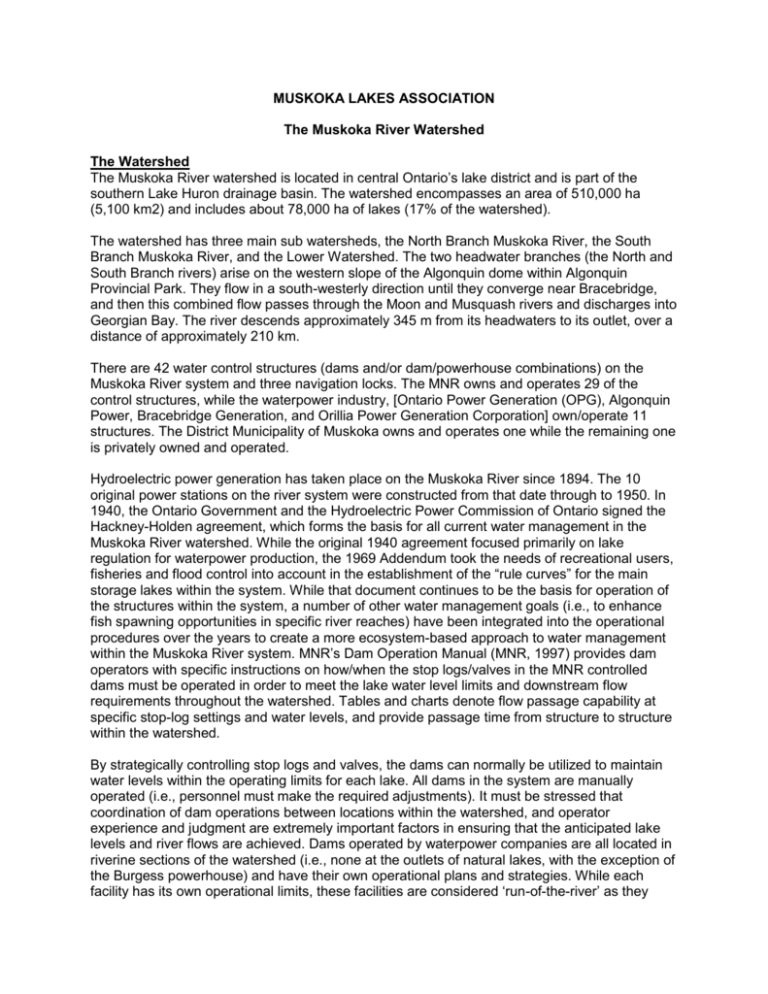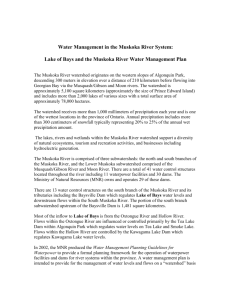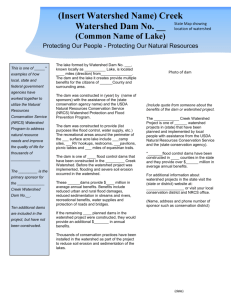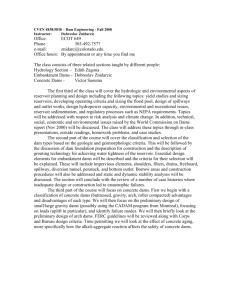The Muskoka River Watershed
advertisement

MUSKOKA LAKES ASSOCIATION The Muskoka River Watershed The Watershed The Muskoka River watershed is located in central Ontario’s lake district and is part of the southern Lake Huron drainage basin. The watershed encompasses an area of 510,000 ha (5,100 km2) and includes about 78,000 ha of lakes (17% of the watershed). The watershed has three main sub watersheds, the North Branch Muskoka River, the South Branch Muskoka River, and the Lower Watershed. The two headwater branches (the North and South Branch rivers) arise on the western slope of the Algonquin dome within Algonquin Provincial Park. They flow in a south-westerly direction until they converge near Bracebridge, and then this combined flow passes through the Moon and Musquash rivers and discharges into Georgian Bay. The river descends approximately 345 m from its headwaters to its outlet, over a distance of approximately 210 km. There are 42 water control structures (dams and/or dam/powerhouse combinations) on the Muskoka River system and three navigation locks. The MNR owns and operates 29 of the control structures, while the waterpower industry, [Ontario Power Generation (OPG), Algonquin Power, Bracebridge Generation, and Orillia Power Generation Corporation] own/operate 11 structures. The District Municipality of Muskoka owns and operates one while the remaining one is privately owned and operated. Hydroelectric power generation has taken place on the Muskoka River since 1894. The 10 original power stations on the river system were constructed from that date through to 1950. In 1940, the Ontario Government and the Hydroelectric Power Commission of Ontario signed the Hackney-Holden agreement, which forms the basis for all current water management in the Muskoka River watershed. While the original 1940 agreement focused primarily on lake regulation for waterpower production, the 1969 Addendum took the needs of recreational users, fisheries and flood control into account in the establishment of the “rule curves” for the main storage lakes within the system. While that document continues to be the basis for operation of the structures within the system, a number of other water management goals (i.e., to enhance fish spawning opportunities in specific river reaches) have been integrated into the operational procedures over the years to create a more ecosystem-based approach to water management within the Muskoka River system. MNR’s Dam Operation Manual (MNR, 1997) provides dam operators with specific instructions on how/when the stop logs/valves in the MNR controlled dams must be operated in order to meet the lake water level limits and downstream flow requirements throughout the watershed. Tables and charts denote flow passage capability at specific stop-log settings and water levels, and provide passage time from structure to structure within the watershed. By strategically controlling stop logs and valves, the dams can normally be utilized to maintain water levels within the operating limits for each lake. All dams in the system are manually operated (i.e., personnel must make the required adjustments). It must be stressed that coordination of dam operations between locations within the watershed, and operator experience and judgment are extremely important factors in ensuring that the anticipated lake levels and river flows are achieved. Dams operated by waterpower companies are all located in riverine sections of the watershed (i.e., none at the outlets of natural lakes, with the exception of the Burgess powerhouse) and have their own operational plans and strategies. While each facility has its own operational limits, these facilities are considered ‘run-of-the-river’ as they have a limited water storage capability and limited ability to influence river flows. Most importantly, the operation of these facilities is coordinated with the operation of the MNR controlled structures to ensure that appropriate flow conditions are maintained. Water management planning has been initiated in Ontario in response to the opening of the province’s electricity market to competition in May 2001. The MNR’s objective of the water management planning process is to “contribute to the environmental, social and economic wellbeing of the people of Ontario through the sustainable development of waterpower resources and to manage those resources in an ecologically sustainable way for the benefit of present and future generations. This will be achieved through the management of water levels and flows as they are affected by the operation of waterpower facilities and associated water control structures. MNR’s Bala North and Bala Dams MNR’s Bala North and Bala South dams are located at the main outlets of Lake Muskoka – the largest lake in the watershed. They control water levels on Lake Muskoka up to the Port Carling dam to the north and Bracebridge Falls (on the North Muskoka River) to the east. Water from the entire Muskoka watershed up to this point drains through these dams. Outflow from the dams enters the Bala Reach of the Moon River. The dam controls a drainage area of 4683 km2and the surface area of the lake of 120 km2. Both dams were originally constructed in 1915 and have since been repaired/upgraded several times. The North dam is 4 m high and contains six sluices with 7/8 stop logs, being approximately 35 m in length. The South dam is also 4 m in height, and contains eight sluices (with 8 stop logs each) and approximately 24 m of overflow spill wall for a total length of 58 m. The dams are operated under the Hackner-Holden agreement. The dams are located at the lower end of the watershed and complex operation of the dams is required. Flooding can occur both upstream and downstream of the dams during heavy rainfall events and a balance is required between flooding the lake and the downstream Bala Reach. Outflows greater than 283 cms (“cubic meters per second”) causes downstream flooding. The downstream operating flows below the Bala Dams are shown in the adjacent chart. A 85 cms outflow is maintained where possible during the winter for down stream power production. A minimum flow of 3.0 cms is required for downstream water quality. The normal summer operating range for the lake is 0.24 m with a target operating level of 225.4 m GSD. A fall drawdown of 9 cm from September 1 to November 1 is to assist lake trout spawning and there is a maximum winter drawdown between October 15 and March 1 of 0.45 m for lake trout egg protection. Any dam operation must be coordinated between the Baysville, Port Sydney and Port Carling dams upstream and OPG must be contacted every time any log changes are made The dams are used for flood protection, recreation, navigation, fisheries and power production purposes. MUSKOKA RIVER WATERSHED FLOW CHART









